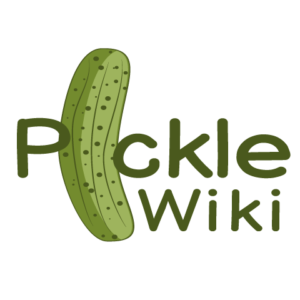If you have ever been to a pickle bar at a quality delicatessen, you are well aware that there are many different types of pickles out there. Odds are you will not like all of them equally, so it helps learn a little more about them before chowing down.
Keep reading to learn about how all these traits apply to all the different pickle types and become the ultimate pickle connoisseur.
Dill Pickles
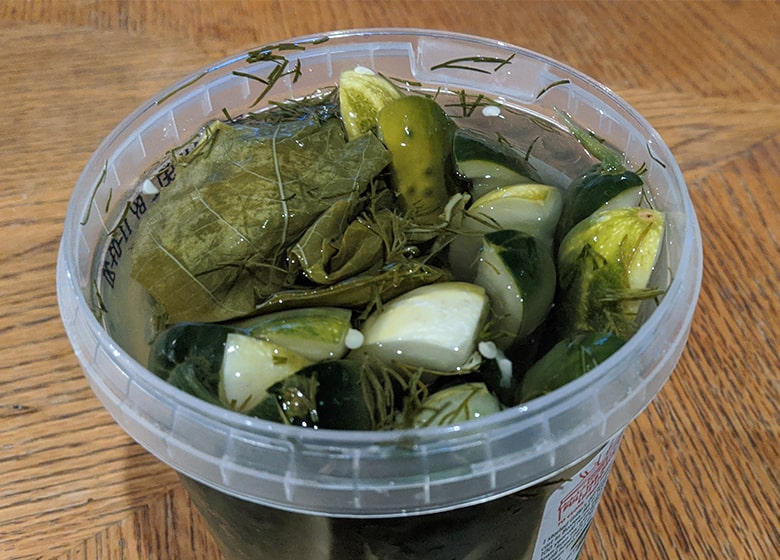
When you think of the quintessential apple in your head, you probably think of a Red Delicious or a Granny Smith. Sure, there are dozens of apples out there, but those are the most famous two tried-and-true types. Similarly, when you think of an average pickle in your head, you are probably thinking of a dill. Dills are well known by their appearance:
- Exactly the same shape as a cucumber (because it is one) but less than a fourth of the size
- Unpeeled
- A lighter green color on the inside, bordering on yellow
In addition, dills usually come whole when bought in a jar, in the same vinegar in which they were made. However, some pickle companies like Vlasic choose to use the famous “Vlasic cut,” where they are cut in fourths lengthwise. This creates a triangular-shaped slice with two sides of the interior and one side with the peel, making a juicy consistency with a slight crunch.
Sometimes dills can also come sliced widthwise as chips, but this is not as common as many other pickle types.
How It Is Made
Dill pickles derive their name from how they are made: with actual dill. Besides the requisite cucumbers and vinegar, dill weed and dill seed are put into the jar before the pickling process begins. That dill is slowly dissolved by the vinegar, leaking into the pickle and giving it that fresh signature taste we all know and love.
Not all dill pickles you see in the supermarket come plain, though. Many additional ingredients are often added to them before the pickling process for an extra flavor boost. Those can include:
- Basic pickling spice
- Spicy peppers
- Carrots
- Peas
- Other vegetables
In particular, vegetables graduate the dill pickle from a topping to a full-fledged side dish with all the trimmings.
The Kosher Dill Difference
The most famous addition to the dill pickle, however, is garlic. While you may be surprised about the idea of garlic being in pickles, you should not be surprised about the outcome: the kosher dill pickle.
The most famous variation of the dill pickle, the kosher dill is not always literally kosher. So if you eat kosher, make sure you check the label on the pickle jar for a “K” or “O-U” symbol before purchasing.
The name kosher dill is derived from the fact that they are made in the same style as the classic kosher delis in New York City. Most of those delis are overseen by a Rabbi and are officially kosher. But many kosher dill pickles you find in a supermarket across the country are not.
Source: The Cookful
Taste
Dill pickles have a nice, even mix of soft and crunch, making it an intriguing consistency. They taste sour but not too sharp. They can be a bit soggy, so make sure you have a napkin ready if you are not using a knife and fork.
Kosher dills are best eaten alone since the garlic flavoring makes them a bit salty and risks masking other flavors as a topping. Plain dill pickles do quite well on:
- Burgers
- Hot dogs
- Chicken Sandwich
- Cold cut sandwiches
As you go into other dill pickle flavorings, like spicy and with vegetables, you are less likely to use it as a topping. But at the end of the day, the choice is yours. Some adventurous types like kosher and flavored dill pickles on their potato chips, for instance; the juice blends well with their crispiness. They also pair nicely with a handful of otherwise bland raw carrots.
Source: Spoon University
Half-Sour and Sour Pickles
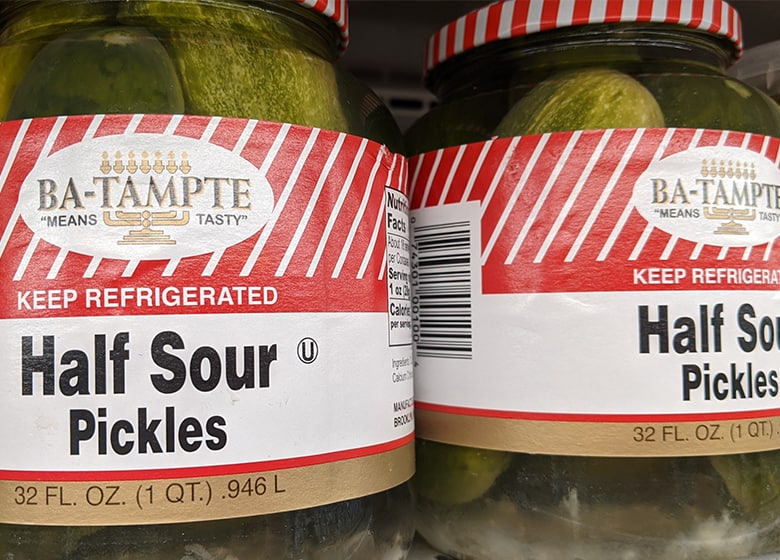
Anybody who has had a sour or half-sour pickle before knows quite well that they taste different and look a bit different from the dill pickle. Sour and half-sour are almost always left in their original cucumber shape after they shrink, but the similarities end there.
For one thing, sour pickles are a darker shade than dill and noticeably so. Meanwhile, half-sour are way darker than sour, almost matching the color of the original cucumber. How these pickles get this way has everything to do with how they are made.
General Recipe
Half-sour and sour pickles are the exceptions to the rule: they are not made by fermenting them in vinegar. Instead, they use a brine that includes a mix of:
- Water
- Pickling salt
- Spices of your choosing
- Garlic
The spices specifically are up to you; just make sure there are items like horseradish or light pepper. They need to be flavors that work with the general pickle taste, not against it. Making the brine is the most critical part of getting this right.
First, water and salt are heated and mixed, then cooled back to room temperature. Then the other ingredients are mixed in. Finally, the brine is poured into the jar with cucumbers and the lid is sealed.
The only difference between sour and half-sour pickles is time. If the pickles are pulled from the brine 6 to 8 weeks into fermentation, they are considered half-sour. Any more than that, and they are fully sour.
As with Dill pickles, there are more than just one type of half-sour and sour pickles you can find in the store. This variety depends mostly on spices included. With the unique taste of the sour pickle and the lack of vinegar, solid sides like vegetables do not keep and thus are typically not included in the brine. They would not mix with the pickles themselves either.
Uses for Sour Pickles
Although the recipes for sour (and half-sour) pickles may be limited, their uses are far and wide. For one thing, they are healthy since cucumber is a vegetable, and you are using water instead of vinegar. Just watch your salt intake if that is an issue for you. Otherwise, sour pickles can be a great healthy snack that will give you the crunch you need without resorting to potato chips.
Since a lot of flavor comes from their outsides, you might want to slice these for sandwiches like you would with dill pickles. A sliced sour pickle is mostly the soft, lightly flavored inside. That means it will taste more like a cucumber at that point than a pickle.
That lighter but still sour taste does make sour pickles the perfect fit for pickle juice though.
Sources:
Bread and Butter Pickles
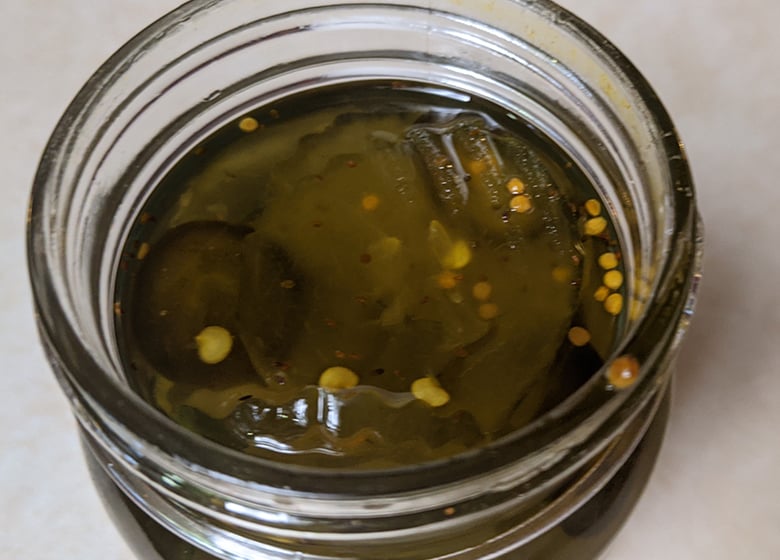
While no actual bread or butter is used to make this type of pickle, it achieved its name from, essentially, being the pickle’s bread and butter. This style is quite different from the previous two but is just as famous. There is also an excellent chance you have never seen a whole, uncut bread and butter pickle before.
That is because when you buy them in the store, bread and butter pickles are almost exclusively pre-sliced for your convenience. They may have some additional garnishments inside as well.
Uses
Why are they sliced, though? Because unlike their dill and sour brethren, bread and butter pickles were explicitly designed as toppings, not sides. They do, of course, have a sour tint, but the flavor is also quite sweet, making it perfect to put on your sandwich and melt in with the rest of its flavor. When you order a burger or chicken sandwich from places like:
- McDonald’s
- Burger King
- Chik-fil-A
- White Castle
And they put pickles on it, those are bread and butter pickles.
Also of note is the fact that relish, the typical hot dog topping, is made from bread and butter pickles. (You may have noticed the general flavor of the two is the same.) To do this, manufacturers simply chop up these pickles and sometimes add some extra salt to make their taste really stand out.
How They Are Made
The recipe for bread and butter pickles is quite interesting, as it is essentially a combination of our first two types, dill and sour. But of course, there is also an exciting twist. The recipe might be a little complex for those at home, so we recommend you give dill or sour a try before attempting bread and butter.
To make the brine, you will first need an exciting combination of ingredients that includes:
- Vinegar
- Sugar
- Mustard seed
- Celery seed
- Coriander
- Sweet onions
While vinegar and celery seed may not surprise you, the bottom four might. Not every single bread and butter recipe uses these exact same ingredients; they are more or less for flavor fine-tuning depending on brand and what the preparer prefers.
In any case, once the brine is set up, cucumbers must be chopped before they are placed in the jar. This saves the eater work later on, of course, but the main benefit is to make sure that the brine saturates the whole pickle evenly. Otherwise, the outside would be crunchier than the inside, making it an inconsistent and ineffective food topping.
Sources: Taste of Home
Gherkin Pickles
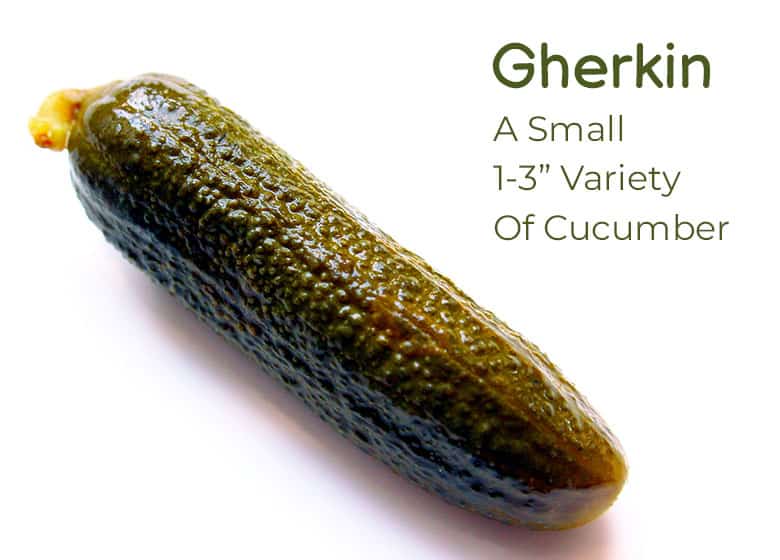
Gherkin pickles are derived from gherkin cucumbers. Easy. But what is a gherkin cucumber? That is the more complicated question. A gherkin cucumber is a smaller version of a regular cucumber genetically quite a bit different from the original. Being almost of another species entirely gives the gherkin cucumber and pickle a different but interesting taste.
It is important to note, however, that not all small cucumbers are gherkins. Gherkins are a specific cucumber (and eventually pickle) that have a uniquely sour taste. Apart from size, it may be hard to tell a gherkin apart from a sour pickle. But when you bite into one, you will know for sure.
How to Make a Gherkin Pickle
As you might expect, a gherkin pickle is made similarly to its dill cousin. You will first need a brine of:
- Mostly vinegar
- Sugar
- Pickle spices
- Salt
As you can see, because the original cucumber flavor is slightly different, you will definitely need salt to enhance the taste. And because a gherkin is naturally significantly sourer than dill, you will still need to add sugar to the mix.
Another critical difference in gherkin pickle preparation is time. If you need pickles for next week’s barbeque, this pickle is not for you unless you plan on just buying some at the store. While a regular dill pickle can be ready in a few days, gherkins can take well over a month to be prepared, sometimes way longer depending on the growth and maturity during harvest.
The Many Uses of the Gherkin
If it is so much trouble, you may be thinking, “Why bother?” Well, simply put, the gherkin is perhaps the most versatile pickle out there. Its size and taste mean it can be used both for toppings and as a snack. Many have tried to stick a fork in a bottle of gherkins and only eat one. Many have failed.
Besides snacking, some of the other interesting uses of gherkins include:
- Salads
- Cocktail recipes
- Dessert
- Sauces
If you have ever been to a salad bar and wondered what pickles were doing there, that is because gherkins pair surprisingly well with them. You probably would never put a bread and butter or a half-sour pickle on a salad because it would completely mask the overall taste. Gherkins, however, are much more subtle and blend right in with your tomatoes and egg salad.
While you may be able to wrap your head around pickles in salads (cucumbers are there anyway), the thought of them in a cocktail probably does not compute. Then again, is it really that far off of a concept from putting an orange slice in a Blue Moon or fruit in sangria? Gherkins pair nicely with gin cocktails or a particular sour martini.
Gherkins even work well as desserts. Allow them to dry or pat dry, and then coat them in sugar syrup for a particularly sweet taste. Powdered sugar will not work here, unfortunately.
But perhaps the tastiest use of a gherkin is as a sauce. Often certain sauces are too much of a base. They need a little bit of a kick to have that little extra spiciness, so to speak. Chop up some gherkins and give them a try the next time you have:
- Mayonnaise
- Tartar sauce
- Salad dressing
And you will be pleasantly surprised by the fun flavor combination that results.
Source: NDTV Food
Cinnamon Pickles
If you have ever received a pickle that is red before, they are not lying to you: that is indeed a pickle. Though we are used to most pickles’ standard green color, these ones look nothing of the sort. Cinnamon pickles are a sharp red color and are typically chopped up into small pieces when put in the jar.
Though the appearance is quite the radical departure from the other types of pickles we have discussed so far, the cinnamon pickles recipe is really not all that different. The chopped pickles (cut up even more so than bread and butter) are placed in a jar of vinegar. As their name implies, the secret to the red color is cinnamon as a main ingredient.
The result is a pickle that is sour but also extra-sharp at the same time. The flavor invites unusual pickle ingredients, such as hot red peppers and onions.
Uses for Cinnamon Pickles
With their naturally spicy nature, cinnamon pickles are certainly a food you would not want to nosh on right out of the jar. It is a flavor that only works as a condiment on beef hamburgers and similar foods.
Source: A Pinch of Joy
Candied Pickles
You have heard of candied pickles before, just like you may have had candied bacon or candied apples. Foods that are “candied” do not actually become candy like Starbursts or Skittles, though. Instead, candied foods like candied pickles are coated in sugar that is then allowed to harden.
Like many people, if you are drawn to the pickle mainly for its crunch, you definitely have to give the candied pickle a try if you have not already. They can be used as a topping, but as a snack is a bit more common.
When we talk about candied pickles, it is essential to note that we are not referring to a different type, per se, but a unique variation on the varieties we discussed earlier. The electrifying results can be:
- Candied dill
- Candied bread and butter
- Candied sour
Gherkins, with their quite different taste, are not usually candied. But you are welcome to give it a try.
How to Make Candy Pickles
You can sometimes buy candied pickles at the store or your local fair. But making candied pickles is pretty easy. And you will only need to wait a day! Here is how it is done:
- Start with pickles of your choosing and sugar, along with ½ a cup of vinegar
- Drain the pickles as dry as possible and put them in a bowl
- Add the sugar and vinegar and mix.
- Seal the mixture tight.
- Let sit at room temperature for 4 hours, or until sugar is dissolved.
- Refrigerate overnight.
Your result the next day will be phenomenal candied pickles in the style you love.
Source: Paula Deen
Hungarian Pickles
Perhaps just as fascinating as the candied pickle is the Hungarian pickle that, yes, was invented in Hungary. You may have seen them before: jars in the pickle section that just look like they are filled with big yellow blobs. It certainly looks odd if you do not know what it is, so you probably took one look and moved on.
That is a shame because Hungarian pickles taste just like an average sour pickle; they are just made a completely different way. No vinegar is used in the brine. Instead, pickling occurs thanks to the yeast’s fermentation given off by the bread in the jar (those yellow blobs).
Yeast still does the trick, though, giving you a pickle that has a softer, non-salty taste we experience from vinegar. We do not recommend eating the bread, though.
Source: Home Stratosphere
Pickles that Are Not Cucumbers
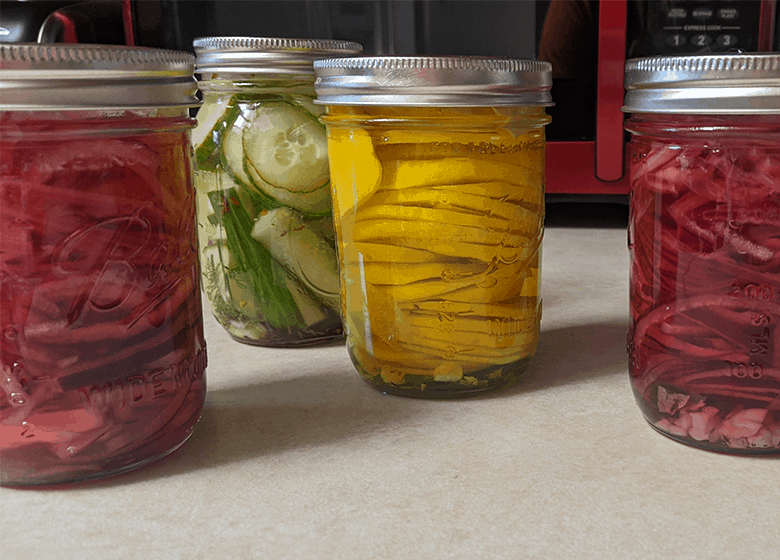
To “pickle” something, as a technical definition, means to soak a food in vinegar until it ferments and shrinks. Thus far, we have discussed pickled cucumbers since their name is most commonly shortened simply to “pickles,” especially in the United States. However, cucumbers are not the only food that can be pickled. Other common pickled foods include:
- Pickled peppers
- Pickled tomatoes
- Pickled carrots
- Pickled cabbage
- Watermelon rind
- Pickled pork
Pickled Peppers
You may have heard of pickled peppers from good old Peter Piper, but how many peppers can Peter Piper pick if people have a particular preference for produce? All kidding aside, pickled peppers are a fascinating way to spice up your sandwiches, but with a hint of sour too.
Bell peppers have the best density to come out with a good texture, although the more adventurous types may prefer jalapeño. Any way you make it, pickled peppers have a unique taste that enhances the spices and makes them less overbearing.
Pickled Tomatoes
Pickled tomatoes, unlike sun-dried tomatoes, keep and enhance the flavor rather than diminish it. Even though they will shrink a bit, grape tomatoes have the necessary crunch you will need to make this side really stand out.
Pickled Carrots
Carrots are among the healthiest vegetables out there. The problem for many well-intentioned dieters, however, is that raw carrots do not exactly scream flavor. Sure, you can steam them, but that cooks out a lot of the nutritional value. Matters are made even worse if you use salt in the process.
As an alternative to steaming your carrots (or to make them last if they are going bad), you can pickle them. Doing so enhances their somewhat dull flavor without messing with your daily calorie count, thanks to the use of vinegar instead of salt.
Source: Minimalist Baker
Pickled Cabbage
You have probably eaten pickled cabbage plenty of times but just referred to it under a different name: sauerkraut. It is made by first chopping up the cabbage into thin slices and then fermenting/pickling it in vinegar. Once complete, it is often eaten as a side dish mixed with carrots and other vegetables.
However, sauerkraut has a wide variety of uses besides that, such as for:
- Cubano sandwiches
- Mixed with coleslaw
- Soup
- Egg salad
- Baked potato
The seamless way pickled cabbage blends in makes it quite the popular topping for countless other sandwiches as well.
Source: Wildbrine
Watermelon Rind
Watermelon rind probably got its name because “pickled watermelon” does not sound as appealing. But that is technically what it is. The most eco-friendly of the bunch, watermelon rind takes all those pieces of the watermelon you would have had to throw in the garbage and makes them edible- by pickling them, of course.
Making this is obvious: just throw the pieces in a jar with vinegar and wait. After a week or two, those hard pieces will soften up a little bit and have a tastier flavor than you might think.
Pickled Pork
“Pickles” do not have to limit themselves to produce either. You can pickle almost anything, not excluding meat. The most famous example is pickled pork. This food is beloved by some for giving the meat a much sweeter, less dry taste.
Since meat is involved, recipe guidelines to make the pork adequately cooked are much more rigid than that of vegetables and fruits. Luckily the vinegar does an excellent job within needing any added steps from an oven or fryer. You will have to let it sit for at least two weeks to make sure any toxins are removed out into the vinegar, though.
Before beginning, make sure you remove any fat or bone that may interfere with the pickling process. Getting the flavoring right here is also a little bit tricky, so make sure you come prepared with ingredients like:
- Brown sugar
- Malt
- Bay leaves
- Pepper
Sources: The Nibble
The Australian Women’s Weekly Food
Recap
The world of pickled cucumbers alone is vast and delicious. Most start with the same concept- taking cucumbers and shrinking them through some sort of fermentation- but then quickly deviate to new and exciting flavor alternatives. While we have strived to extensively cover the main types of pickles you might encounter, many more remain for you to discover.
That is only for the main cucumber pickle too. Almost any vegetable (and plenty of meats too) can be pickled for a fascinating variety of flavor combinations. Give them a try as your next side or on your next sandwich, and you will definitely enjoy the experience.
